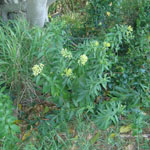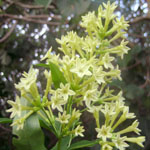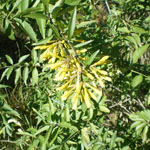Chilean cestrum
Common name:
- Chilean cestrum
Scientific name:
- Cestrum parqui L'Her.
Other common names:
- Green cestrum
- Green poison berry
Plant status
Catchment management authority boundaries
Regionally prohibited in the East Gippsland, West Gippsland, Port Phillip and Western Port catchments.
Regionally controlled in the Wimmera, Goulburn Broken, North East catchments.
Restricted in the Mallee, Glenelg Hopkins, North Central and Corangamite catchments.
Plant biology
Appearance
Shrub (or bush)
Description
Chilean cestrum is an erect shrub that grows to 3m high.
Stems
Chilean cestrum has whitish young branches and darker woody older stems which are striated at the base. They are mottled nearer the top and one or more stems emerge from each crown of the plant.
Leaves
Older leaves are dark green while younger leaves are light green and alternate along branches.
Leaves have short stalks, are lance-shaped and hairless. They grow up to 12cm long and 1 to 2.5cm wide and their margins undulate.
They have an unpleasant odour when crushed.
Flowers
Chilean cestrum flowers are greenish-yellow, sessile and are borne in loose clusters at the ends of branches. They have tubular corollas of 2.5cm length with five small terminal lobes.
Flowers have an unpleasant odour by day but are fragrant at night.
Fruit
Chilean cestrum fruit are a purplish-to-black, shiny, ovoid berry about 1cm long. They contain one or two seeds in a dark purple pulp.
Growth and lifecycle
Method of reproduction and dispersal
Chilean cestrum reproduces from both creeping roots and seed.
Water is an effective method of dispersal for this plant, as well as birds which eat the fruit and excrete viable seeds.
Dispersal can also occur by pieces of cut root dragged by cultivation equipment. This establishes new plants in clean areas.
Rate of growth and spread
Chilean cestrum is long-lived. The plants are 2 years old before flowering occurs.
Seedbank propagule persistence
Chilean cestrum can produce more than 2000 seeds per plant with seeds remaining dormant in the soil for many years.
Preferred habitat
Chilean cestrum prefers warm-temperate and subtropical regions, mainly on alluvial soils along streams. Often promoted as a garden plant, it has become naturalised as a weed in towns and higher rainfall rural areas. It readily invades bushland margins.
The weed is frost-hardy and tolerant to waterlogging.
Distribution
There are only a few occurrences of Chilean cestrum in Victoria, primarily in East Gippsland, Central and North East districts.
Growth calendar
The icons on the following table represent the times of year for flowering, seeding, germination, the dormancy period of Chilean cestrum and also the optimum time for treatment.
| Jan | Feb | Mar | Apr | May | Jun | Jul | Aug | Sep | Oct | Nov | Dec | |
|---|---|---|---|---|---|---|---|---|---|---|---|---|
| Flowering | ||||||||||||
| Seeding | ||||||||||||
| Germination | ||||||||||||
| Dormancy | ||||||||||||
| Treatment |
Impact
Impact on ecosystems and waterways
Chilean cestrum prefers moist habitats and invades riparian environments, such as riverbanks and wetlands. The plant grows well on alluvial river flats often to the exclusion of most other vegetation.
The weed forms extensive stands along disturbed areas preventing growth and regeneration by indigenous plants.
Agricultural and economic impacts
Chilean cestrum grows vigorously when neglected and is toxic to animals including cattle, sheep, horses, pigs and poultry.
Animals are attracted to Chilean cestrum and will graze on it.
Infested areas have to be fenced off to prevent stock losses given the toxicity of the plant.
The plant would most likely not become a weed of crop or pastures as it takes several years to mature.
The plant is difficult to control as it grows robustly, reproducing sexually and vegetatively. Presence of this species can affect land value.
Social value and health impacts
Because of its ability to build a large population in moist habitats, Chilean Cestrum has the potential to block access to waterways and affect recreational activities such as swimming, boating and bird watching.
Plant material is poisonous to animals and humans if chewed or swallowed. Humans may also develop skin rashes from handling the plant.
Management
Prescribed measures for the control of noxious weeds:
- application of a registered herbicide
- physical removal.
Read about prescribed measures for the control of noxious weeds.
Other management techniques
Changes in land use practices and spread prevention may also support Chilean cestrum management after implementing the prescribed measures.